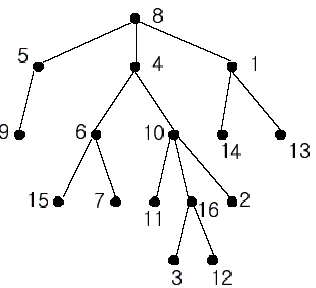POJ 1330 Nearest Common Ancestors(Targin求LCA)
| Time Limit: 1000MS | Memory Limit: 10000K | |
| Total Submissions: 26612 | Accepted: 13734 |
Description

For other examples, the nearest common ancestor of nodes 2 and 3 is node 10, the nearest common ancestor of nodes 6 and 13 is node 8, and the nearest common ancestor of nodes 4 and 12 is node 4. In the last example, if y is an ancestor of z, then the nearest common ancestor of y and z is y.
Write a program that finds the nearest common ancestor of two distinct nodes in a tree.
Input
Output
Sample Input
2 16 1 14 8 5 10 16 5 9 4 6 8 4 4 10 1 13 6 15 10 11 6 7 10 2 16 3 8 1 16 12 16 7 5 2 3 3 4 3 1 1 5 3 5
Sample Output
4 3
思路
最近公共祖先模板题
#include<iostream>
#include<cstdio>
#include<cstring>
#include<vector>
using namespace std;
const int maxn = 10005;
struct Edge{
int to,next;
}edge[maxn];
vector<int>qry[maxn];
int N,tot,fa[maxn],head[maxn],indegree[maxn],ancestor[maxn];
bool vis[maxn];
void init()
{
tot = 0;
for (int i = 1;i <= N;i++) fa[i] = i,head[i] = -1,indegree[i] = 0,vis[i] = false,qry[i].clear();
}
void addedge(int u,int to)
{
edge[tot] = (Edge){to,head[u]};
head[u] = tot++;
}
int find(int x)
{
int r = x;
while (r != fa[r]) r = fa[r];
int i = x,j;
while (i != r)
{
j = fa[i];
fa[i] = r;
i = j;
}
return r;
}
void Union(int x,int y)
{
x = find(x),y = find(y);
if (x == y) return;
fa[y] = x; //不能写成fa[x] = y,与集合合并的祖先有关系
}
void targin_LCA(int u)
{
ancestor[u] = u;
for (int i = head[u];i != -1;i = edge[i].next)
{
int v = edge[i].to;
targin_LCA(v);
Union(u,v);
ancestor[find(u)] = u;
}
vis[u] = true;
int size = qry[u].size();
for (int i = 0;i < size;i++)
{
if (vis[qry[u][i]]) printf("%d\n",ancestor[find(qry[u][i])]);
return;
}
}
int main()
{
int T;
scanf("%d",&T);
while (T--)
{
int u,v;
scanf("%d",&N);
init();
for (int i = 1;i < N;i++)
{
scanf("%d%d",&u,&v);
addedge(u,v);
indegree[v]++;
}
scanf("%d%d",&u,&v);
qry[u].push_back(v),qry[v].push_back(u);
for (int i = 1;i <= N;i++)
{
if (!indegree[i])
{
targin_LCA(i);
break;
}
}
}
return 0;
}
#include<stdio.h>
#include<string.h>
#include<iostream>
#include<algorithm>
#include<math.h>
#include<vector>
using namespace std;
const int MAXN=10010;
int F[MAXN];//并查集
int r[MAXN];//并查集中集合的个数
bool vis[MAXN];//访问标记
int ancestor[MAXN];//祖先
struct Node
{
int to,next;
}edge[MAXN*2];
int head[MAXN];
int tol;
void addedge(int a,int b)
{
edge[tol].to=b;
edge[tol].next=head[a];
head[a]=tol++;
edge[tol].to=a;
edge[tol].next=head[b];
head[b]=tol++;
}
struct Query
{
int q,next;
int index;//查询编号
}query[MAXN*2];//查询数
int answer[MAXN*2];//查询结果
int cnt;
int h[MAXN];
int tt;
int Q;//查询个数
void add_query(int a,int b,int i)
{
query[tt].q=b;
query[tt].next=h[a];
query[tt].index=i;
h[a]=tt++;
query[tt].q=a;
query[tt].next=h[b];
query[tt].index=i;
h[b]=tt++;
}
void init(int n)
{
for(int i=1;i<=n;i++)
{
F[i]=-1;
r[i]=1;
vis[i]=false;
ancestor[i]=0;
tol=0;
tt=0;
cnt=0;//已经查询到的个数
}
memset(head,-1,sizeof(head));
memset(h,-1,sizeof(h));
}
int find(int x)
{
if(F[x]==-1)return x;
return F[x]=find(F[x]);
}
void Union(int x,int y)//合并
{
int t1=find(x);
int t2=find(y);
if(t1!=t2)
{
if(r[t1]<=r[t2])
{
F[t1]=t2;
r[t2]+=r[t1];
}
else
{
F[t2]=t1;
r[t1]+=r[t2];
}
}
}
void LCA(int u)
{
//if(cnt>=Q)return;//不要加这个
ancestor[u]=u;
vis[u]=true;//这个一定要放在前面
for(int i=head[u];i!=-1;i=edge[i].next)
{
int v=edge[i].to;
if(vis[v])continue;
LCA(v);
Union(u,v);
ancestor[find(u)]=u;
}
for(int i=h[u];i!=-1;i=query[i].next)
{
int v=query[i].q;
if(vis[v])
{
answer[query[i].index]=ancestor[find(v)];
cnt++;//已经找到的答案数
}
}
}
bool flag[MAXN];
int main()
{
//freopen("in.txt","r",stdin);
//freopen("out.txt","w",stdout);
int T;
int N;
int u,v;
scanf("%d",&T);
while(T--)
{
scanf("%d",&N);
init(N);
memset(flag,false,sizeof(flag));
for(int i=1;i<N;i++)
{
scanf("%d%d",&u,&v);
flag[v]=true;
addedge(u,v);
}
Q=1;//查询只有一组
scanf("%d%d",&u,&v);
add_query(u,v,0);//增加一组查询
int root;
for(int i=1;i<=N;i++)
if(!flag[i])
{
root=i;
break;
}
LCA(root);
for(int i=0;i<Q;i++)//输出所有答案
printf("%d\n",answer[i]);
}
return 0;
}
POJ 1330 Nearest Common Ancestors(Targin求LCA)的更多相关文章
- POJ - 1330 Nearest Common Ancestors(基础LCA)
POJ - 1330 Nearest Common Ancestors Time Limit: 1000MS Memory Limit: 10000KB 64bit IO Format: %l ...
- poj 1330 Nearest Common Ancestors 单次LCA/DFS
Nearest Common Ancestors Time Limit: 1000MS Memory Limit: 10000K Total Submissions: 19919 Accept ...
- POJ 1330 Nearest Common Ancestors(裸LCA)
Nearest Common Ancestors Time Limit: 1000MS Memory Limit: 10000K Total Submissions: 39596 Accept ...
- POJ 1330 Nearest Common Ancestors(Tarjan离线LCA)
Description A rooted tree is a well-known data structure in computer science and engineering. An exa ...
- poj 1330 Nearest Common Ancestors 裸的LCA
#include<iostream> #include<cstdio> #include<cstring> #include<algorithm> #i ...
- POJ 1330 Nearest Common Ancestors / UVALive 2525 Nearest Common Ancestors (最近公共祖先LCA)
POJ 1330 Nearest Common Ancestors / UVALive 2525 Nearest Common Ancestors (最近公共祖先LCA) Description A ...
- POJ.1330 Nearest Common Ancestors (LCA 倍增)
POJ.1330 Nearest Common Ancestors (LCA 倍增) 题意分析 给出一棵树,树上有n个点(n-1)条边,n-1个父子的边的关系a-b.接下来给出xy,求出xy的lca节 ...
- POJ 1330 Nearest Common Ancestors(lca)
POJ 1330 Nearest Common Ancestors A rooted tree is a well-known data structure in computer science a ...
- POJ 1330 Nearest Common Ancestors 倍增算法的LCA
POJ 1330 Nearest Common Ancestors 题意:最近公共祖先的裸题 思路:LCA和ST我们已经很熟悉了,但是这里的f[i][j]却有相似却又不同的含义.f[i][j]表示i节 ...
- LCA POJ 1330 Nearest Common Ancestors
POJ 1330 Nearest Common Ancestors Time Limit: 1000MS Memory Limit: 10000K Total Submissions: 24209 ...
随机推荐
- Incorrect string value异常解决
mysql数据库的一个问题 1366-Incorrect string value:'\xE5\x8D\xA1\xE5......' for column 'filename' at row 1 问题 ...
- DOM Document节点类型详解
在前面 DOM 概况 中,我们知道了 DOM 总共有 12 个节点类型,今天我们就来讲下 DOM 中最重要的节点类型之一的 document 节点类型. 1.概况 Javascript 通过 Docu ...
- byte[] 转字符串 中文乱码
闲来无事,写了一个UWP的UDP/TCP小Demo,网上找了个网络调试助手,就兴冲冲的开始玩耍 结果“鸡同鸭讲”: 讲英文的时候大家都是abc,hello man!how are you? 讲中文的时 ...
- Mininet的内部实现原理简介
原文发表在我的博客主页,转载请注明出处. 前言 之前模拟仿真网络一直用的是Mininet,包括写了一些关于Mininet安装,和真实网络相连接,Mininet简历拓扑的博客,但是大多数都是局限于具体步 ...
- 仿各种APP将文章DOM转JSON并在APP中以列表显示(android、ios、php已开源)
背景 一直以来都想实现类似新闻客户端.鲜城等文章型app的正文显示,即在web editor下编辑后存为json,在app中解析json并显示正文. 网上搜过,没找到轮子.都是给的思路,然后告知是公司 ...
- 由一次程序崩溃引起的对new表达式的再次学习
1. 起因 某天,一个同事跟我反馈说在windows上调试公司产品的一个交易核心时出现了使用未初始化的指针导致后台服务崩溃的情况.示例代码如下所示: struct sample { ][]; //.. ...
- wap端开发必须基础
1. nitial-scale=1.0 确保网页加载时,以 1:1 的比例呈现,不会有任何的缩放. 在移动设备浏览器上,通过为 viewport meta 标签添加 user-scalable=no ...
- nios II--实验4——按键中断硬件部分
按键中断 硬件开发 新建原理图 1.打开Quartus II 11.0,新建一个工程,File -> New Project Wizard…,忽略Introduction,之间单击 Next&g ...
- 将Microsoft Ajax Minifier集成到VS2013对JS、CSS进行编译时压缩
在网站发布中,一般要将js,css文件压缩减少体积,以减少在HTTP请求中的流量.将Microsoft Ajax Minifier集成到VS2013中就可以对JS.CSS进行编译时压缩. VS2013 ...
- 链栈的C语言实现
/* 功能:栈的链表实现 Author:lxm Date: 20160511 */ #include <stdio.h> #include <stdlib.h> #define ...
